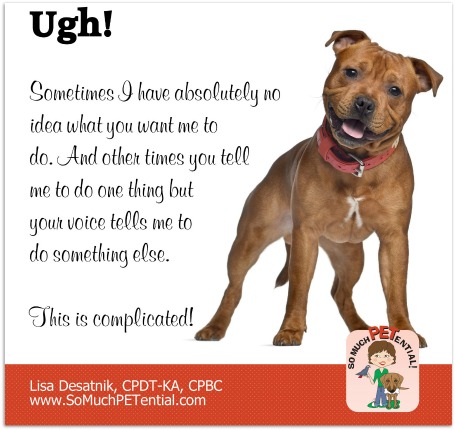Have you ever stopped to think about how difficult it must be to be a dog (or other animal) living with humans many times larger than him who speaks a completely unknown language, who has rules that often times are secret until you do something to break them, and who expects you to easily understand what it is they want you to do at any given moment?
 Oh my, we need to give our pets a whole lot more understanding and respect!
Oh my, we need to give our pets a whole lot more understanding and respect!
Think about it for a minute, just how complicated we make learning and succeeding with us. Do you use the word ‘down’ to indicate that you want your dog to lay down, and also, in the heat of a moment, yell ‘down!’ to indicate you want your dog to go from jumping on you to having all four paws on the ground? Do you ever yell ‘no!’ to your dog but your dog has no idea what he should do instead? How many different ways do you call your dog to come, in addition to the word you had actually practiced teaching? (I bet you don’t even know an exact number for that last question.)
One more way to help your pet learn (and help you be a more effective teacher) is to keep track of your cues – verbal and nonverbal – and make sure that you are using distinctively different cues for different behaviors. (I wrote more about teaching cues in this blog post.)
Here is another example to give you thought. I have heard people say ‘no bite’ when their dog goes to take a treat from their hand with too much pressure or ‘no jump’ when their dog’s two front paws leave the ground to land on an incoming human.
There are a number of problems with this. Firstly, this is assuming that your dog understands what the words ‘bite’ and ‘jump’ mean…and actually, if your dog had been taught by you what those cues meant, logically then, if you used those cues AFTER another word, then, wouldn’t your dog DO the behavior of jump or bite since it was cued by you? The other thing here is that, more than likely, in these situations, your voice may be raised and your body language may be doing more to heighten your dog’s arousal which could result in your dog doing more of the behaviors you do not like.
Here is another tendency of humans. When frustration sets in as ears develop selective listening, it is the nature of many of us to get louder and more persistent with our voices. I have seen it happen time and again. Dog handlers ask their dog to come or to sit, and if the behavior is not done, the handler repeats words over and over, with more and more velocity.
And yet, another complication is the fact that we convey even more information by the tone of our voice.
Think about your own self and the difference between your emotional and physiological response to hearing ‘come here!’ in how a deep throated, loud tone from a face with tense muscles vs a high-pitched tone from a smiling face. In training, it is important to separate yourself from your emotions and use verbal tones to elicit the behavior from your pet that you want to see.
Remember, when your dog is not doing what you want it to do, it is not behaving to purposefully get under your skin. Your dog is simply doing what works for him to get something it values. In that moment, your dog is telling you the value is not associated with you. Additionally, as your dog’s teacher, if your dog is not doing what you want, ask yourself how well YOU have taught him with consistency and lots of positive practice in varying situations. It is not the cue that determines the future rate of behaviors. It is the reinforcement that comes after behaviors. Cues are simply green lights that tell learners that opportunity for good things is NOW.
Can I be of more help to you and your pet? Please contact me!






